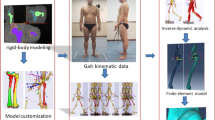Abstract
Purpose
In this study, we presented movable surface models to help medical students understand the multiaxial movements of the hip joint. The secondary objective was to demonstrate a simple method to make movable surface models for other researchers.
Methods
We used 166 surface models of the virtual human, and the commercial software was used for all the processes described in this study. Virtual joints were created for the hip joint of the surface models to simulate realistic movements of the joints. Bone surface models were processed to maintain the original shape of the bones during movement. Muscle surface models were processed to express deformation of the muscle shapes during movement. Next, the muscle and bone surface models were moved over six movements of the hip joint (flexion, extension, abduction, adduction, lateral rotation, and medial rotation). The surface models of these six movements were saved and packaged in a PDF file.
Results
The PDF file enabled users to see the stereoscopic shapes of the bones and muscles of the hip joint and to scrutinize the six movements on the X, Y, and Z axes of the joint.
Conclusion
The movable surface models of the hip joint of this study will be helpful for medical students to learn the multiaxial movements of the hip joint. We expect to develop simulations of other joints that can be used in the education of medical students using the materials and methods described in this study.



Similar content being viewed by others
References
Battulga B, Konishi T, Tamura Y, Moriguchi H (2012) The effectiveness of an interactive 3-dimensional computer graphics model for medical education. Interact J Med Res 1:e2
Benn ML, Pizzari T, Rath L, Tucker K, Semciw AI (2018) Adductor magnus: an EMG investigation into proximal and distal portions and direction specific action. Clin Anat 31:535–543
Elser F, Braun S, Dewing CB, Giphart JE, Millett PJ (2011) Anatomy, function, injuries, and treatment of the long head of the biceps brachii tendon. Arthroscopy 27:581–592
Kim BC, Chung MS, Park HS, Shin DS, Park JS (2015) Accessible and informative sectioned images and surface models of the maxillofacial area for orthognathic surgery. Folia Morphol 74:346–351
Lewis TL, Burnett B, Tunstall RG, Abrahams PH (2014) Complementing anatomy education using three-dimensional anatomy mobile software applications on tablet computers. Clin Anat 27:313–320
Park HS, Chung MS, Shin DS, Jung YW, Park JS (2013) Accessible and informative sectioned images, color-coded images, and surface models of the ear. Anat Rec (Hoboken) 296:1180–1186
Park JS, Chung MS, Hwang SB, Lee YS, Har DH, Park HS (2005) Visible Korean human: improved serially sectioned images of the entire body. IEEE Trans Med Imaging 24:352–360
Romanov R (2018a) ZIVA VFX Creating Ziva Tissues. https://youtu.be/4jMhsGdNflM. Accessed 2 Feb 2021
Romanov R (2018b) ZIVA VFX How to Drive Ziva Bones. https://youtu.be/S8YkLInC12o. Accessed 2 Feb 2021
Romanov R (2018c) ZIVA VFX How to Make Fixed Attachments. https://youtu.be/4-ajVAkZ-RU. Accessed 2 Feb 2021
Romanov R (2018d) ZIVA VFX How to Make Sliding Attachments. https://youtu.be/QPU69TLgq6c. Accessed 2 Feb 2021
Shin DS, Chung MS, Park JS, Park HS, Lee S, Moon YL, Jang HG (2012) Portable document format file showing the surface models of cadaver whole body. J Korean Med Sci 27:849–856
Shin DS, Park JS, Park HS, Hwang SB, Chung MS (2012) Outlining of the detailed structures in sectioned images from Visible Korean. Surg Radiol Anat 34:235–247
Zilverschoon M, Vincken KL, Bleys RL (2017) The virtual dissecting room: creating highly detailed anatomy models for educational purposes. J Biomed Inform X 65:58–75
Funding
Not applicable.
Author information
Authors and Affiliations
Contributions
CYK: Protocol development, Data analysis, Manuscript writing; YWJ: Data analysis; JSP: Project development; Data collection and management, Manuscript editing; All authors have read and approved the manuscript.
Corresponding author
Ethics declarations
Conflict of interest
Authors have no potential conflicts of interest to disclose.
Additional information
Publisher's Note
Springer Nature remains neutral with regard to jurisdictional claims in published maps and institutional affiliations.
Rights and permissions
About this article
Cite this article
Kim, C.Y., Jung, Y.W. & Park, J.S. The Visible Korean: movable surface models of the hip joint. Surg Radiol Anat 43, 559–566 (2021). https://doi.org/10.1007/s00276-021-02697-7
Received:
Accepted:
Published:
Issue Date:
DOI: https://doi.org/10.1007/s00276-021-02697-7




